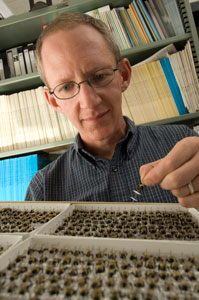Pollination study shows importance of maintaining natural areas around crops
Surrounding agricultural crops with natural, biologically diverse areas helps provide habitat for important pollinators and promotes the stability and richness of crops worldwide.
 Surrounding agricultural crops with natural, biologically diverse areas helps provide habitat for important pollinators and promotes the stability and richness of crops worldwide, according to a new study by an international team of scientists recently published in the journal Ecology Letters.
Surrounding agricultural crops with natural, biologically diverse areas helps provide habitat for important pollinators and promotes the stability and richness of crops worldwide, according to a new study by an international team of scientists recently published in the journal Ecology Letters.
The article is a collaboration of researchers from 11 countries involved in 29 studies, including a study of Michigan blueberry fields by Michigan State University (MSU) AgBioResearch entomologist Rufus Isaacs. Maintaining the delivery of ecosystem services, including those provided by pollinators such as honeybees and other species of bees, is an important topic confronting farmers and scientists.
The researchers analyzed various crops, pollinators and biomes -- a large, distinctive complex of plant communities created and maintained by climate -- around the world and found overall lower pollination in crop areas that were farther from natural areas. Increasing distance from natural areas meant less stability of pollination, fewer species of flower-visiting insects, lower rates of visitation to flowers and less crop pollination.
Wild bees and other pollinator species that use natural habitats – including beetles, ants and flies – were significantly affected by the distance from their natural areas. Therefore, policies favoring the protection and restoration of natural areas in agricultural communities are especially valuable for sustaining crop pollination by wild pollinators. In contrast, natural habitats had little effect on honeybees because these are managed colonies that are brought to farms by beekeepers.
Isaacs, an MSU professor in the Department of Entomology and an MSU Extension specialist, worked with graduate student Annie Kirk to collect the blueberry data that were used for the analysis. He said he is encouraged by the results.
“This broad, global analysis supports ongoing research showing that it matters where a crop field is located for the level of pollination that wild bees and other species can provide,” Isaacs said.
“It also suggests that maintaining unmanaged habitat within farm landscapes will support wild bees that contribute to the reliability of pollination.”
Isaacs and his research group at MSU are evaluating plantings of wildflowers sown to attract and build bee populations on farmland. The long-term goal is to measure how much benefit these plantings provide to growers of crops that depend on bees for pollination, such as fruits and vegetables.
“This new study helps solve a piece of the pollination puzzle,” Isaacs said. “Our findings help demonstrate the value that natural habitat and wild bees provide to agriculture.”



 Print
Print Email
Email




